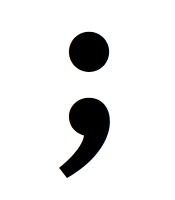I thought I had.
I mentioned that I did indeed proofread. He commented that he thought not, considering I'd misused the semicolon 5 times on the first page. (And yes, I did use a lot of them in the early years). So at that point, I researched the proper usage of a semicolon. And considering that all the writers in my local writing group had no idea the proper usage (and one is a copy editor for a newspaper), I thought I'd post the rules of usage on here.
The most common use of a semicolon separates two complete sentences, closely related. Two independent clauses. Two sentences that could stand on their own. So basically, if you can't replace it with a period, you can't use a semicolon. There are some other usages, that I will share, but that is the primary one that I see misused with a lot of writers. Here is a pretty good description, taken from Wikipedia.
And if you still don't believe me, here are a few more links to convince you.
http://theoatmeal.com/comics/semicolon
http://owl.english.purdue.edu/owl/resource/607/04/
http://writing.wisc.edu/Handbook/Semicolons.html
http://grammar.quickanddirtytips.com/semicolons.aspx
Usage
Semicolons are followed by a lower case letter, unless that letter is the first letter of a proper noun. Modern style guides recommend no space before them, and one space after. Modern style guides also typically recommend placing semicolons outside of ending quotation marks—although this was not always the case. For example, the first edition of the Chicago Manual of Style (1906) recommended placing the semicolon inside ending quotation marks.[5] Applications of the semicolon in English include:- Between items in a series or listing containing internal punctuation, especially parenthetic commas, where the semicolons function as serial commas:
- She saw three men: Jamie, who came from New Zealand; John, the milkman's son; and George, a gaunt kind of man.
- Several fast food restaurants can be found within the cities: London, England; Paris, France; Dublin, Ireland; and Madrid, Spain.
- Examples of familiar sequences are: one, two, and three; a, b, and c; and first, second, and third.
- (Fig. 8; see also plates in Harley 1941, 1950; Schwab 1947).
- This is by far the most frequent use currently.[6]
- Between closely related independent clauses not conjoined with a coordinating conjunction
- I went to the basketball court; I was told it was closed for cleaning.
- I told Kate she's running for the hills; I wonder if she knew I was joking.
- Nothing is true; everything is permitted.
- A man chooses; a slave obeys.
- I told John that his shoe was untied; he looked.
- Between independent clauses and semi clauses linked with a transitional phrase or a conjunctive adverb
- Everyone knows he is guilty of committing the crime; of course, it will never be proven.[7]
- It can occur in both melodic and harmonic lines; however, it is subject to certain restraints.
- Of these patients, 6 were not enrolled; thus, the cohort was composed of 141 patients at baseline.
- This is the least common use, and is mostly confined to academic texts.[8]


8 comments:
Personally, I hate the semicolon. I don't like the look of them in novels. However, I do understand that they have a use. From all the research I did on them (because I was like you--a misguided grammaree) what I read here is what I learned. What a simple and easily understood post. Thank you.
Oh, semicolon, my dear friend. I used to abuse them a fair bit, but now I've finally started to use them in moderation. Thank you for the refresher - it's always good to have!
I have heard that even if you use semicolons correctly, it's best to avoid them in writing fiction. Any opinions/insights on this?
This is a really, really informative post! Thank you!
Susan: I once read from an agent, that the overuse of the semicolon is the sign of a beginning writers. Which is funny, because when I first started, I used a ton. I think it was because I felt so "writerly" that I figured the more fancy punctuation I used the better I looked. I still use some, but I do keep an eye on when I need to and when it isn't necessary.
Like most things...there is something to be said for too much of a good thing.
and ignore my "a beginning writers" mistake. lol
I agree that semi-colons are largely misused and misunderstood. Thanks for the tips!
Becca @ The Bookshelf Muse
Personally, I love the semicolon. It just makes so much sense to me, and I've never had a problem knowing where to use it and where not to. But, like others have said, I did use it too much in my first draft. I've tried to go through and eliminate all semicolons, and it's a little painful for me because I do love them so much haha. I may be the only person on earth who can say that...
Post a Comment